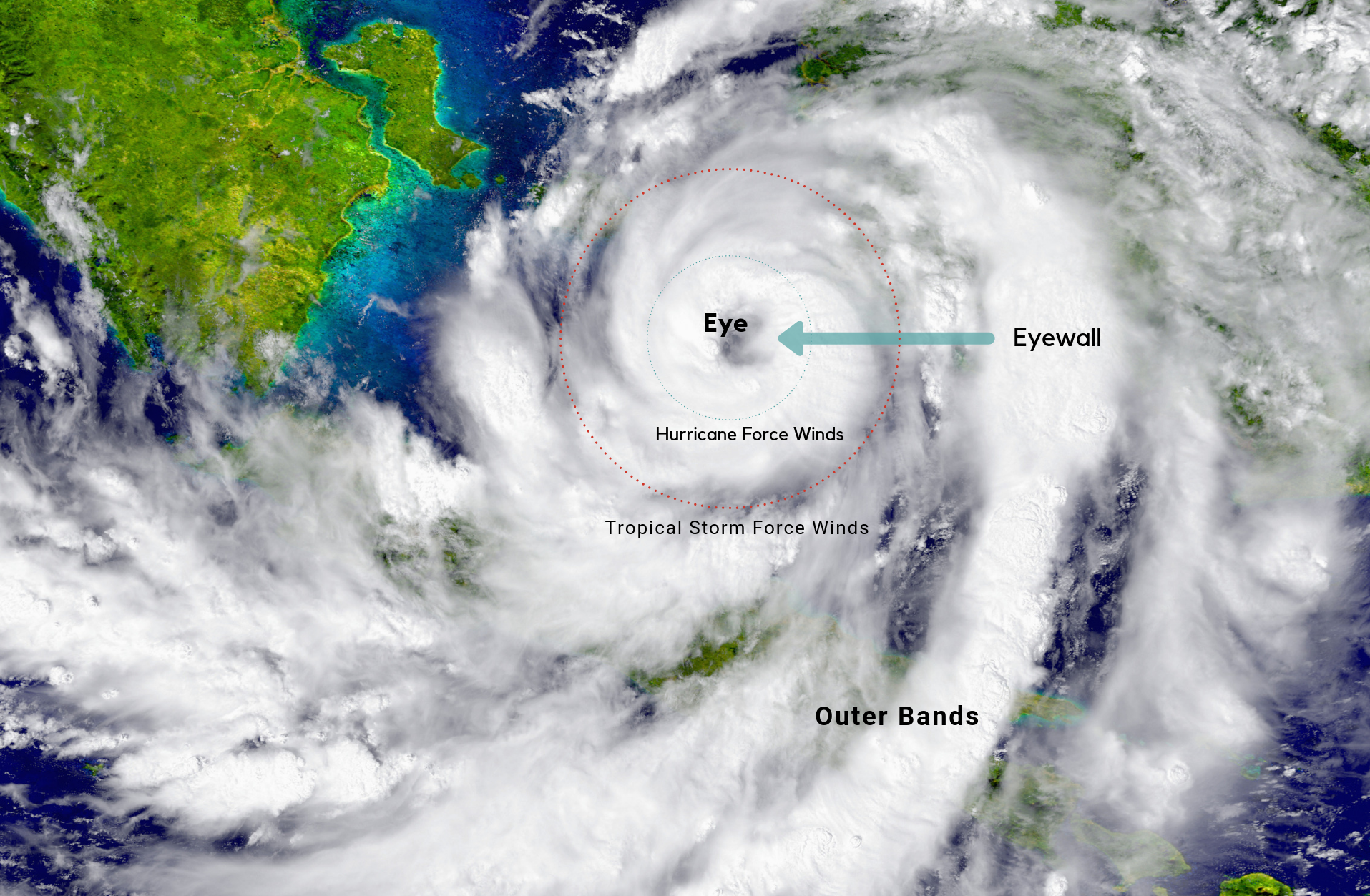Describe the Different Parts of a Hurricane
The eye is an area of very low air pressure. The three parts of the hurricane are.

Nasa How Strong Is That Hurricane
Rainbands - Hurricanes have large.

. The eye is the warmest part of the storm. Hurricanes are the most awesome violent storms on Earth. Eye wall - Around the outside of the eye is a wall made up of very heavy clouds.
They produce winds of 119 kilometers per hour 74 mph or higher. The Spiral Rain Bands-. This is the most dangerous part of the.
Hurricane winds blow in a counterclockwise spiral around the calm roughly circular center called the eye. Hurricanes are tropical storms that form in the Atlantic Ocean with wind speeds of at least 119 kilometers 74 miles per hour. Hurricanes form over warm ocean waters.
Other definitions for Hurricanes. The air then rises and cools forming clouds and thunderstorms. Strongest winds of hurricane in a band surrounding the eye.
Outflow is the high-level clouds moving outward from the hurricane. Hurricane winds have the power to uproot trees and debris turning them into high-speed projectiles. Thats faster than a cheetah the fastest animal on land.
Only tropical cyclones that form over the Atlantic Ocean or eastern Pacific Ocean are called hurricanes. Storm surges are the deadliest result of hurricanes. Hurricanes can also bring strong winds tornados rough surf and rip currents.
The time to prepare for a hurricane is. Caribbean Sea North Atlantic Ocean Gulf of Mexico --hurricane. Hurricanes are large swirling storms.
Different areas of the world have different names for what we call a hurricane. Parts of a Hurricane Eye - At the center of the hurricane is the eye. Parts of a hurricane include.
Surrounding the eye is the eyewall a wall of thunderclouds. The hurricane winds can cause sea levels to rapidly rise as the hurricane makes landfall. Hurricanes have three main parts the calm eye in the center the eyewall where the winds and rains are the strongest and the rain bands which spin out from the center and give the storm its size.
Hurricanes are the most violent storms on Earth. Sometimes they strike land. When wind speeds within such a storm reach 74 mph its classified as a hurricane.
Meteorologists use the Saffir-Simpson Hurricane Wind Scale. The scientific term for all these storms is tropical cyclone. Storm surge and inland flooding have historically been the number one offsite link and two causes of loss of life during hurricanes.
The Eye- innermost portion of the storm. A tropical cyclone is a rotating low-pressure weather system that has organized thunderstorms but no fronts a boundary separating two air masses of different densities. Those with maximum sustained winds of 39 mph or higher are called tropical.
A hurricane is essentially a highly organized mass of severe thunderstorms with rain bands and strong winds circling a a calm central eye. The eye the eyewall and rain bands. Sustained winds of 111-130.
However they are still dangerous and can cause much damage. People call these storms by other names such as typhoons or cyclones depending on where they occur. Hurricane Iniki 1992 had a small compact eye of about 30 kilometers 19 miles across while Hurricane Fernanda 1993 had an enormous eye.
Outflow feeder bands eyewall eye and the storm surge. What does a hurricane need in order to form other than warm ocean water. Whatever they are called tropical cyclones all form the same wayThis website presented by NASAs Global Precipitation Measurement GPM mission provides students and educators with resources to learn about.
Sustained winds of 74-95. These surges can pummel the area engulfing any object its path. Hurricane safety.
Hurricanes tropical storms and tropical depressions pose a variety of threats to people and property. Disturbance in the atmosphere low vertical shear between the levels of the atmosphere relatively moist air in the troposphere generally at least 300 miles from the equator so the Coriolis effect gives the air. This article is part of the NASA Knows.
When hurricanes make landfall they begin to decrease in strength because they no longer have the ocean water from which to gain energy. Sustained winds of 96-110. There are generally no.
They get more pronounced as. Iwas path was unusual typically most hurricanes approach the Islands from the east. In the eye which is roughly 20 to 30 miles wide it is relatively calm and there is little or no rain.
Sustained winds of 131-155. The Eye Wall- dense wall of thunderstorms directly surrounding the eye. Tropical cyclones with maximum sustained surface winds of less than 39 miles per hour mph are called tropical depressions.
Strong Currents Hurricanes can cause flooding injury deaths tornados extremly severe thunder Storms. Parts of a Hurricane Hurricanes have three parts. Feeder bands are the areas of heavy rain and gusty winds fed by the warm ocean.
Sustained winds of of 156 and more. A hurricane consists of five main parts. Up in the clouds water condenses and forms droplets releasing even more heat to power the storm.
Winds from a hurricane can damage buildings and trees. Because hurricanes rotate circularly the center is relatively calm in comparison which is called the eye of the storm and may be as large as 20-30 miles wide or 32-48 km wide. People call these storms by other names such as typhoons or cyclones depending on where they occur.

Hurricane Facts How They Form And How To Prepare World Vision


0 Response to "Describe the Different Parts of a Hurricane"
Post a Comment